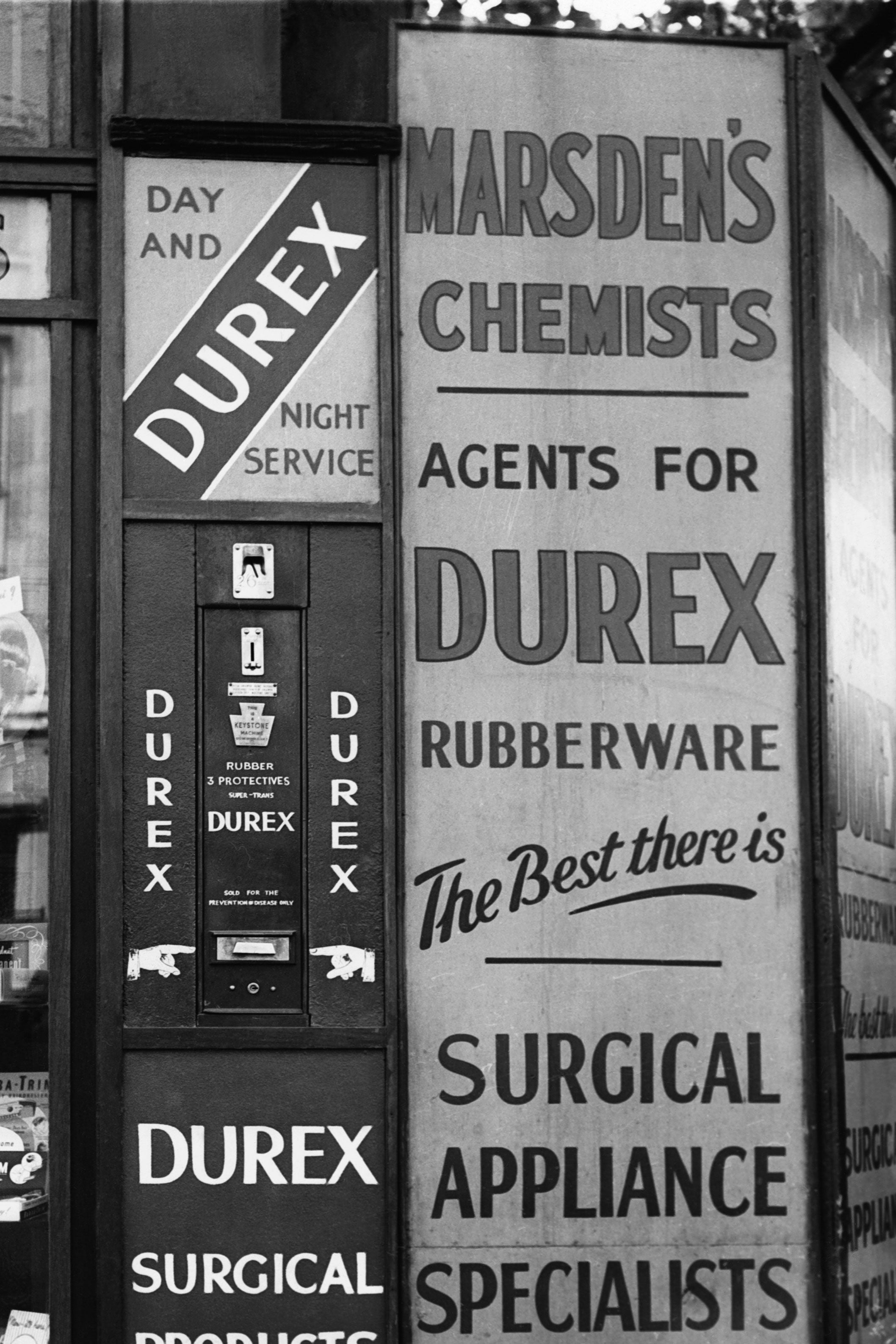Condom Access through the Ages.

A brief history from contraband contraceptives to casual sex.
Maybe you’ve restocked your condom stash from the supply of single-use prophylactics on display outside your RAs dorm room. Maybe you grab a handful of rubbers from a bin every time you visit your favored local dive bar. Perhaps you’ve had the same box of Trojans in your sock drawer since puberty. In any case, no matter your methods of prophylactic procurement, it’s no secret that condoms are widely available across the country—and often, they’re even free.
That wasn’t always the case though. In the 18th century, the idea that you might reach an arm blindly in any direction and land on a complimentary condom was all but ludicrous. So, how did casually distributed contraception come to be? And despite our current near unlimited access, why are we using them less than ever?
Contraband Contraception
You may be surprised to learn that contraception was around long before the 20th century. In fact, throughout the latter half of the 1800s, condoms were pretty widely available. You could find them in pharmacies, doctor’s offices, even mail-order catalogs. But in 1873, all that changed with the passage of the Comstock Act—a decree that made it illegal to send any article “for the prevention of conception” through the mail (for ethical reasons). Soon after, contraception became far more difficult to locate—and deeply stigmatized to sell. So naturally, the business moved underground. Entrepreneurs like Julius Schmid built condom “start-ups” vending rubbers of all kinds in coy packaging calling them things like sheaths, skins, or “rubber goods for gents” rather than tools for preventing pregnancy. And while they couldn’t legally advertise, they were still doing substantial business under the table.
‘Bring our boys home.’
By the time World War I was underway, the health hazards of unprotected sex had become obvious: Circa 1917, nearly 380,000 American soldiers had been diagnosed with some form of VD (costing the U.S. more than $50 million in treatment)—which gave way to a full-on epidemic of sexually transmitted diseases. Fortunately, that gave the government cause to start treating contraceptives like legitimate healthcare essentials: In 1927, the military’s senior medical officers started promoting condom distribution and educational programs for members of the army and navy. Free of charge, condoms were dispatched amongst military men—and as a result, there was a notable decline in STIs—which made the American military among the first major U.S. organizations to support the normalization of condom usage (at the time, the Catholic church was not pleased. Actually, they’re still not pleased).
A 1936 Ruling
In 1932, American birth control activist Margaret Sanger arranged for the first official U.S. shipment of diaphragms from Japan, which U.S. customs wouldn’t allow. Fortunately, that gave way to a 1936 ruling from the federal appeals court claiming that the federal government could not interfere with any doctor’s right to provide contraception to their patients. And by 1938, over 300 birth control clinics were providing contraception (condoms included) to women who couldn't afford it, free of charge.
Condoms behind bars
In 1937, by the time World War II had arrived, to fight venereal disease, the FDA instituted national standards for condom testing—which both helped to legitimize the industry and allowed for quality control amongst condom producers. And for soldiers, that meant sets of three condoms sold for ten cents at “pro stations” placed around army bases.
If you consult military travel guides from the war, alongside famous attractions and churches, you’ll find a guide to “Pro Stations,” each marched with a little devil.
That said, even with new sanctions, for those not at war, the taboo around condoms remained. Rubbers were stigmatized –– which meant vendors didn’t want to put them on display. So instead, at bars and pharmacies, you’d find funny little countertop display cases designed to hold condoms –– complete with bars, or *modesty doors* to “protect women and children from the scandalous condom tins inside.”
Condom as the most popular form of contraception
Here’s the good news: Even while condoms weren’t kosher socially, business was still booming. On the commercial side, sales were doing just fine: From 1955 to 1965, 42% of Americans of reproductive age relied on condoms for birth control, and prophylactic production doubled between 1939 and 1946.
The AIDS Crisis
When the AIDS crisis struck—the New York Times first reported that the disease could be sexually transmitted in 1981. In turn, the surgeon general proposed a push for greater condom promotion programs, but Reagan (among many others) opposed, claiming we ought to still preach abstinence—a decree that was dripping with homophobia.
Condoms go mainstream
Fortunately, though, condom companies across the country were still advertising in mainstream media. They were mailing informational pamphlets to young Americans. And around that time, condoms were newly for sale at all kinds of commonplace retailers: supermarkets, Wal-Marts, concert venues.
STD & HIV rates go down
In 2003, ONE began releasing their individually wrapped, round-packaged condoms—and in cities and states across the country, various initiatives were launched to increase access. HIV/AIDS rates had lowered dramatically since the early ‘90s, and local health care systems were finding that the costs of free condom distribution were far smaller than those of the health care bills for folks who contracted the virus. There was no hard and fast rule at play—and still, condom distribution varies geographically—but in major coastal cities, especially New York City and San Francisco, it became entirely commonplace to find gratis condoms in any major social venue.
Present tense prophylactics
In recent years, while public discourse around sex has certainly skyrocketed, condom sales have not. In fact, from 2007 to 2017, condom use among U.S. high school students fell from 62 percent to 54 percent, according to the CDC. The CDC also reported that, in 2017, there were 200,000 more diagnoses of chlamydia, gonorrhea, and syphilis than the previous year. And according to a 2019 survey conducted by Cosmopolitan and non-profit, Power to Decide, 60% of respondents admitted they rarely or never use a condom—and 50% said they’d never (EVER) used one. Now, it would seem obvious that this is the result of more readily available methods of birth control. The prevalence of IUDs, hormonal patches, and “the pill” quells fears of unwanted pregnancy—and it would seem that that particular safety net makes it easy to indulge in coitus sans contraception (without all the guilt). But the numbers don’t lie: Whether or not we’re seeing a rise in unwanted pregnancy, we are being flagrant with our sexual health by nixing condoms from our regimens. We’ve come a long way since *modesty doors.* How can we do the condom legacy justice?



